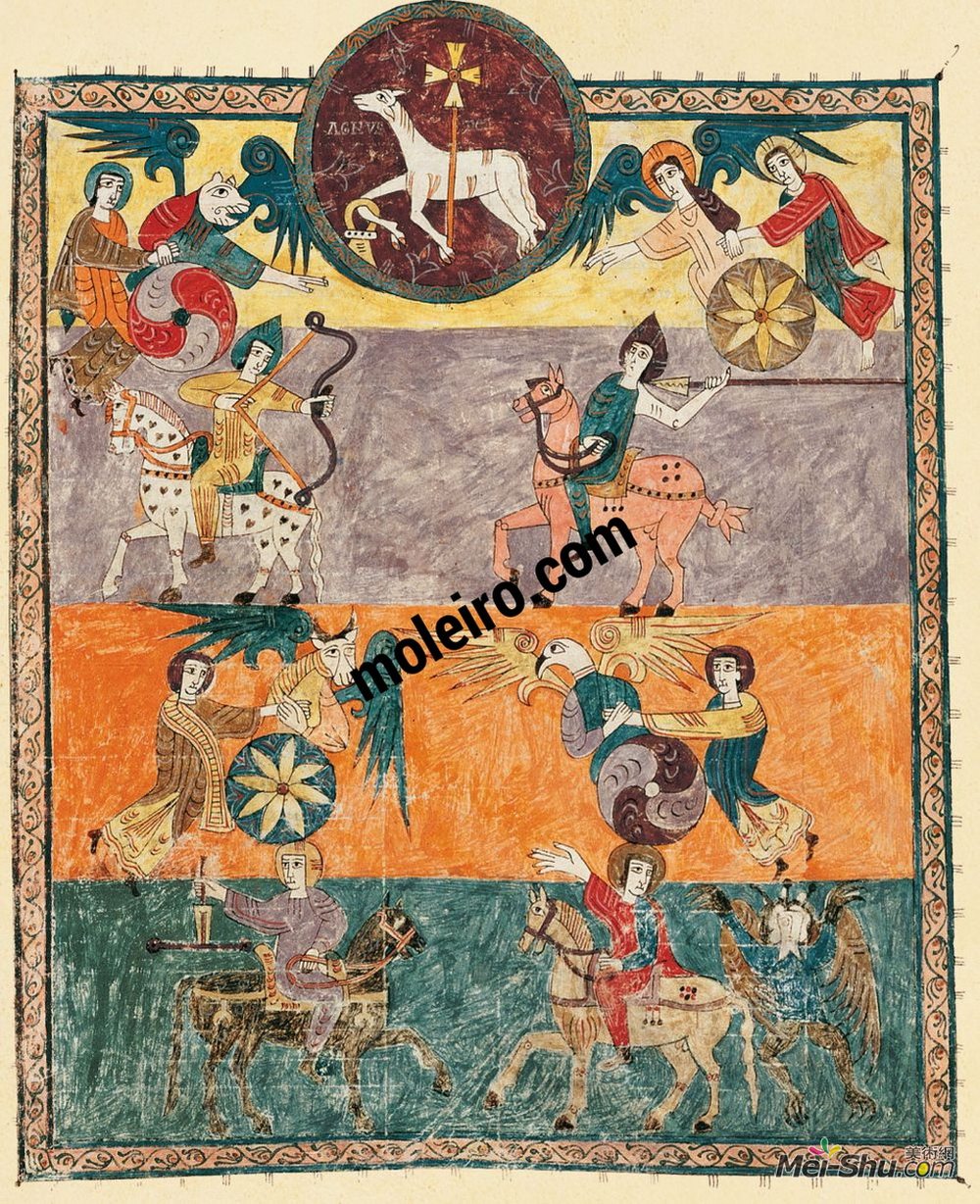 恩德(Ende)高清作品《前四章的开幕》
恩德(Ende)高清作品《前四章的开幕》
作品名:前四章的开幕
艺术家:恩德
年代:c.975
风格:莫札拉布
类型:微型
插图分为四个带,中间的羊羔有一个小十字。描绘了圣约翰的四个景象,所有这些景象都显示他与四个生物之一相伴,这四个生物与西班牙代表模式一致,具有人类同形的外观,其下肢上装饰有星形或螺旋形的圆盘,与火相参照。Ezekiel描述的车轮。这是对用来代表它们的波浪产生的视觉效果的解释。四个具有异形怪物的生物被解读为福音传教士。他们的决定性特征由圣杰罗姆定义,灵感来自于以西结的远见,并在塞都留斯的《卡门·帕斯卡尔》(P.L.:XIX;col.591)中完全定义,该书写于5世纪中叶。最早的模型将在第六世纪和第七世纪的伊比利亚半岛雕塑中找到。微型机使用的模型可以追溯到8世纪和9世纪以岛国和布雷顿·盖龙萨克拉门塔尔(Breton Gellone Sacramentary)为首的三个团体。它们的人类形态起源于多种来源,见于卡罗来纳和爱尔兰的手稿和罗马式的西班牙王国和其他地区的纪念性艺术中。然而,围绕星形的圆圈是古代太阳的表现,中世纪早期西班牙人对于四边形的缩影是独有的,尤其是,是10世纪早期出现的一种转变,当时第三版文本书房被翻新了——可以在为阿方索三世制作的文物馆里找到——这些文物在属于注释的第一个图解干系的手稿中没有找到。然而,这些太阳圆盘只出现在缩影,而不是在壁画中使用其他来源。
Title:The opening of the first four seals
artist:Ende
Date:c.975
Style:Mozarabic
Genre:miniature
The illustration is divided into four bands with the Lamb in the centre holding a pattée cross. Depicted are the four visions of St John all of which show him accompanied by one of the four living beings who, in line with the Hispanic model of representation, are anthropozoomorphic in appearance with a disc decorated with star or spiral shapes upon their lower limbs, in reference to the fiery wheels described by Ezekiel. This is an interpretation of the waves used to represent them originally to produce the visual effect of them turning round. The four living beings with the appearance of theriomorphous monsters were interpreted like the evangelists. Their definitive traits were defined by St Jerome, inspired by Ezekiel’s vision, and completely defined in Sedulius’s Carmen Paschale (P.L.: XIX; col. 591), written in the mid 5th century. The earliest models are to be found in Iberian Peninsula sculptures from the 6th and 7th centuries onwards. The model used for the miniature dates back to three groups in the 8th and 9th centuries headed by the insular and Breton Gellone Sacramentary. Their anthropozoomorphic appearance originated in a variety of sources and can be found in Carolingian and Irish manuscripts and the Romanesque monumental art of Hispanic kingdoms and other areas. However, the circle around a star shape is an ancient representation of the sun exclusive to early medieval Hispanic miniatures in relation to the tetramorph and is, in particular, one of the transformations that arose in the early 10th century when the pictorial part of the third textual version took place was renovated – to be found in reliquaries made for Alfonso III – which are absent in manuscripts belonging to the first illustrated stemma of the Commentaries. However, these sun-shaped discs only appear in miniatures and not in mural paintings which employ other sources.
作品链接:https://www.mei-shu.com/famous/27440/artistic-123904.html
作品类别:油画
免责声明:本站部分公开资料来源于互联网,目的是用于学术交流与讨论,并不代表本网赞同其观点和对其真实性负责。如果您认为我们的侵犯了您的权益,请与我们联系(banquan#mei-shu.com #替换为@),我们将在第一时间删除相关内容。